In 2022, I worked on two impactful B2B content projects as a freelancer. The first was in the sales and marketing niche, where I wrote over 100 articles for a marketing education platform. This project marked my entry into several bottom-of-the-funnel (BOFU) content projects as an SEO content writer.
For those unfamiliar, BOFU content refers to materials aimed at converting potential customers who are close to making a purchase decision.
The second project was in the fintech space, where I served as the lead SEO content writer for a startup. This was also my first time working on BOFU content aimed at ranking on the first page of search engines.
Before these projects, I had never been involved in BOFU campaigns. I also hadn’t had the privilege of seeing my articles rank on Google. Naturally, I was both excited and doubtful about my ability to deliver these articles up to the expected standards. Thankfully, I worked with supportive clients and project managers who assured me their ranking formula was well-tested and proven.
Thirteen months and over 200 articles later, both projects were complete. I decided to take a break to acquire more knowledge in sales and marketing to become a more well-rounded freelancer. Meanwhile, the articles I wrote for both startups were performing exceptionally well on the SERPs. It was my first time seeing so many of my articles ranking high and making a genuine impact on growing startups.
During my break, I published several articles on Medium on B2B and tech topics, which also ranked well on SERPs. In this case study, I’m going to share some key insights I’ve gathered from these experiences and what I’ve learned about the numbers behind ranking high on Google.
Let’s get into it.
What the Numbers Look Like When You Rank Top 10
Before we get deep into it, let’s consider this article I wrote last year on SaaS product development. It has maintained a top 10 position over the past several months.
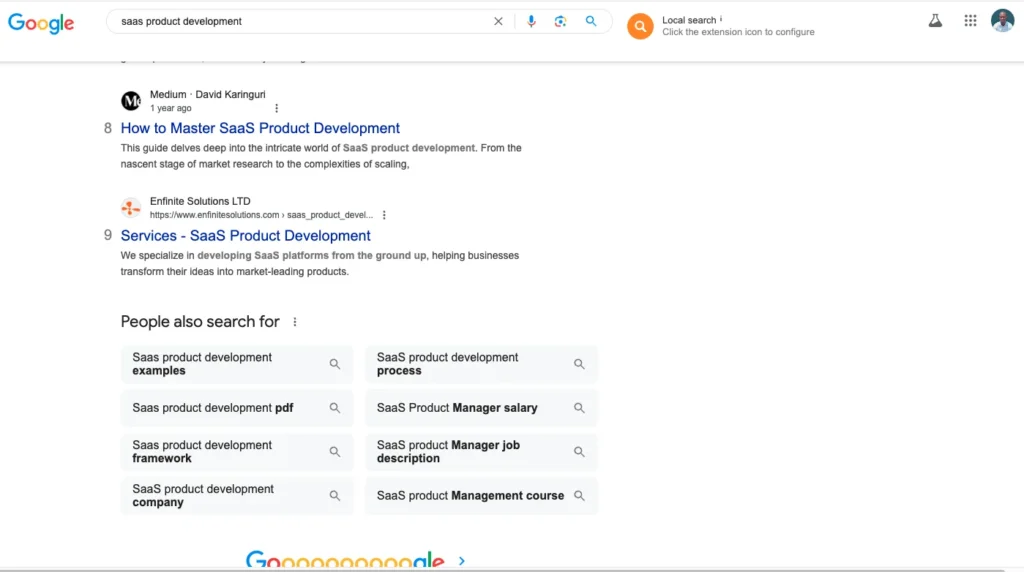
Over that period, it has generated hundreds of views and a few leads.
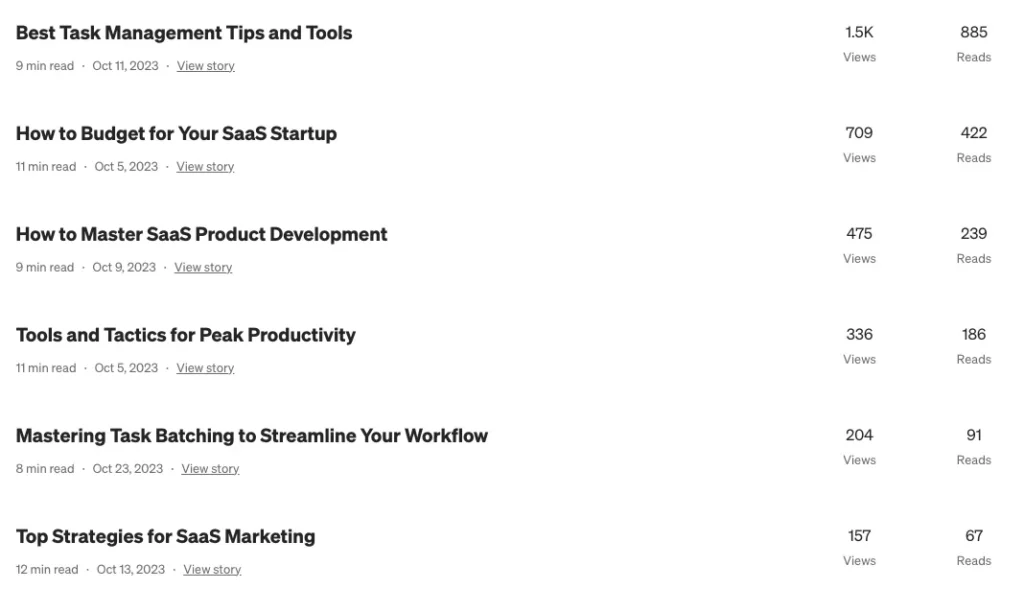
When your article ranks in the top 10 on Google, the numbers can be quite telling about the potential reach and impact of your content. Here’s a detailed look at what these numbers actually mean:
| Ranking Position | CTR (%) | Estimated Monthly Views (for a keyword with 10,000 searches) |
| Top 3 | 20-35% | 500 – 1,500 views |
| 4 – 10 | 5-10% | 100 – 500 views |
When an article ranks in the top 10 results for a competitive keyword in an industry like B2B SaaS, it typically receives 100 to 300 views per month. Actual traffic depends on:
- Keyword Search Volume
- User Intent
- Topic Competitiveness
Achieving a top 3 ranking on Google can significantly boost your content’s visibility and impact. Here are some of the key benefits:
Top 3 Ranking Benefits
- Higher click-through rates (CTR) between 20-35%.
- 500 – 1,000+ views per month for keywords with significant search volume.
- For instance, a 10,000 monthly search volume keyword can generate over 1,500 views if ranked in the top 3.
Positions 4-10
- CTR: Drops to around 5-10%.
- While these positions can still provide meaningful traffic, there is a substantial difference compared to the top 3.
Featured Snippets
- Articles in featured snippets often receive twice the usual CTR.
- Can result in 1,500+ views for a competitive keyword, even from a lower ranking position.
Seasonal Keywords
- Seasonal keywords can see dramatic traffic spikes during peak periods.
- Articles might receive double or triple their usual monthly traffic during these times.
- Worthwhile to invest in content that targets seasonal opportunities.
Keyword Types
- High-Volume Keywords: Generate more traffic but are highly competitive.
- Low-Competition Keywords: Drive less traffic individually, but collectively help build a content portfolio and authority in the niche.
Long-Tail Keywords
- Typically have lower search volumes but attract more targeted traffic.
- Often have a higher conversion potential.
- Ranking for multiple long-tail keywords can lead to a steady stream of engaged visitors.
Goal of Top 10 Rankings
Beyond attracting views, the goal is to convert those views into meaningful interactions:
- Capturing Leads
- Driving Sales
- Building Brand Awareness
What These Numbers Mean for You
The numbers behind ranking in the top 10 tell an important story about the level of effort and scale needed to drive significant traffic and conversions. Here’s a deeper breakdown of what these numbers mean for you and your content strategy:
1. Scaling Content Production
To generate meaningful traffic, you need to cover a wide array of topics, which means targeting hundreds of keywords and producing hundreds of articles. Ranking well requires consistent output.
For instance, having 100 articles ranking on Google means 100 x 100 views a month, which totals to 10,000 views. This kind of volume can lead to steady growth and significant traffic over time.
Note: It’s important to note that content production needs to be strategic. Instead of randomly selecting topics, create a comprehensive content plan that focuses on clusters of related keywords. Content clusters help you build authority around a particular topic, making it easier to rank for both short-tail and long-tail keywords.
2. Conversion Rates and Traffic
On average, conversion rates from organic search traffic are typically 1% to 3%. This means that with 10,000 monthly views, you could potentially generate between 100 to 300 leads per month. The key here is understanding how to optimize content for conversions.
In my case, I leave a CTA that includes my contact information on my blog posts. This has resulted in various people reaching out to me for backlink opportunities, collaboration opportunities, and more.
Conversion Optimization: Include clear calls to action (CTAs) within your articles. Whether it’s downloading a guide, signing up for a newsletter, or booking a demo, make sure every piece of content has a defined goal. Use in-content CTAs, pop-ups, and well-placed banners to capture leads effectively.
User Intent Alignment: Aligning content with user intent is crucial. Understanding the intent behind a keyword helps you create content that meets the specific needs of your audience, increasing the likelihood of conversions.
3. Content Quality and Consistency
The key to scaling is both consistency and quality. Publishing new content regularly increases your chances of ranking for more keywords, which in turn drives more traffic. Aim to publish at least 4-8 articles per month to maintain momentum and increase visibility.
Not every article will be a high performer, and that’s okay. The goal is to build a diverse content portfolio where a percentage of your articles become top performers. In my experience, about 10-20% of your content will drive the majority of your traffic. It’s essential to analyze and identify which articles are performing well and replicate their success.
Consistent content updates are also a good practice. Google values fresh content, so periodically updating articles with new data, examples, or insights can help maintain or improve their rankings.
4. Balancing High-Competition and Low-Competition Keywords
Ranking for high-competition keywords can take time and a significant amount of effort. For some of my clients, I have combined strategies like Medium/Pinterest posting and on-page optimization to get an edge.
It’s important to balance your content strategy by targeting both high-competition and low-competition keywords. Low-competition keywords may not generate as much traffic individually, but they provide quicker wins and help establish your website as an authority over time.
Low-Competition Keywords: These keywords are often less popular but can still attract valuable, targeted traffic. By ranking for multiple low-competition keywords, you can create a steady stream of visitors who are highly engaged and more likely to convert.
High-Competition Keywords: These are often high-volume keywords that require more time, quality backlinks, and a comprehensive content approach to rank. When you do manage to rank, the rewards can be substantial in terms of traffic and visibility.
5. Analyzing the Numbers
Once you’ve identified the articles that are driving the most traffic, it’s crucial to double down on what’s working. Look for patterns in the types of content, topics, or formats that are performing well. I found that articles with detailed how-to steps had higher engagement and lower bounce rates, which helped inform future content strategies for my blogs.
For example, if how-to guides are consistently ranking well, consider expanding that format to cover more related topics.
Content Repurposing: High-performing content can be repurposed to reach different audiences or amplify its impact. Turn successful blog posts into videos, infographics, or slide decks. This not only helps reach a broader audience but also strengthens your authority in the niche.
What It Takes to Rank on SERPs Today
Ranking on search engine result pages (SERPs) requires more than just publishing content and hoping for the best. It involves a strategic approach that considers multiple factors impacting your rankings. Here’s a detailed look at what it takes to rank on SERPs today:
1. Content Quality is Non-Negotiable
Google prioritizes content that provides genuine value, is well-researched, and addresses user intent comprehensively. High-quality content is detailed, actionable, and solves the reader’s problem effectively.
In-Depth Research: Articles that go beyond the basics and provide detailed insights are more likely to rank. This means including data, expert opinions, case studies, and unique perspectives that set your content apart from the competition.
Readability and Engagement: Use engaging formats like bullet points, subheadings, visuals, and storytelling techniques to keep readers on the page longer. Metrics like dwell time and bounce rate are crucial indicators that tell Google whether users find your content valuable.
2. Keyword Research and Intent Matching
Understanding user intent is a key factor in creating content that ranks well. Keywords should be selected not only based on search volume but also on the intent behind them.
Informational vs. Transactional Content: Different types of content serve different purposes. Informational keywords require in-depth guides and how-tos, whereas transactional keywords may call for product comparisons, reviews, or landing pages.
Content Clusters and Topic Authority: Create content clusters around related keywords. Topic clusters help Google understand that you have in-depth coverage on a particular subject, which can improve your ability to rank across related searches.
3. Technical SEO is Critical
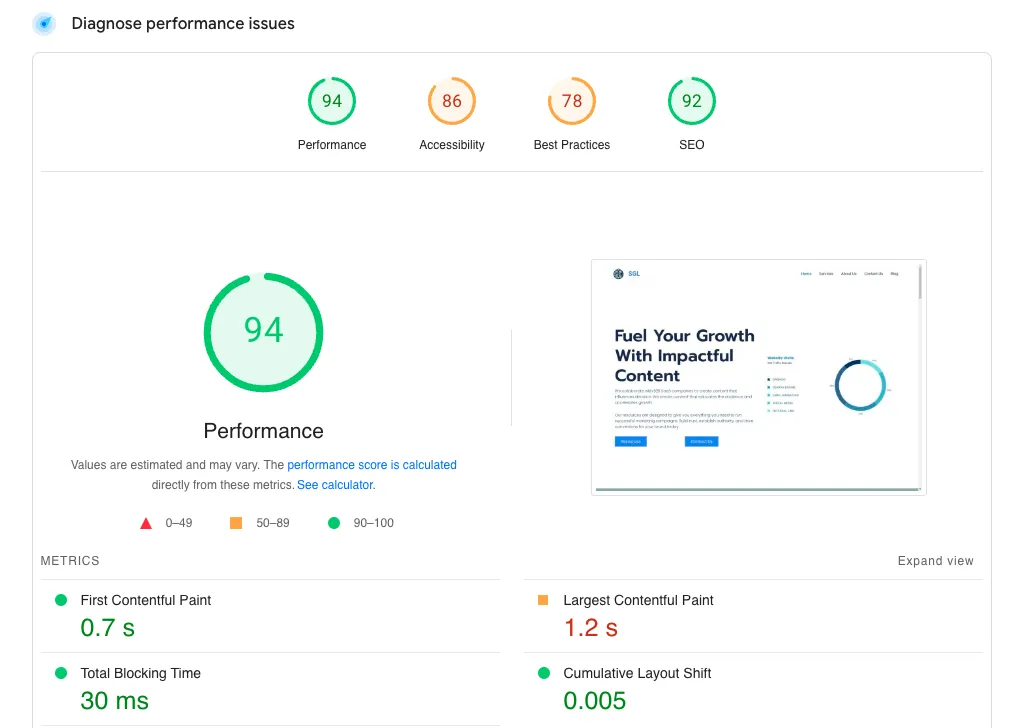
Technical aspects of your site can significantly impact your ability to rank. Ensuring your website is well-optimized is crucial for search engines to crawl and index your content effectively.
Site Speed and Mobile Friendliness: Fast-loading pages and mobile responsiveness are essential ranking factors. Users are likely to bounce if a page takes too long to load, especially on mobile devices.
Indexing and Crawlability: Make sure that all important pages are crawlable by search engines. Use tools like Google Search Console to identify indexing issues and fix them promptly.
Structured Data (Schema Markup): Adding structured data helps search engines better understand your content, increasing your chances of appearing in rich snippets, which can boost visibility.
4. Building Authority Through Backlinks
Backlinks remain one of the most critical factors for ranking in competitive niches. High-quality backlinks from authoritative sites signal to Google that your content is trustworthy.
Guest Posting and Outreach: One way to earn backlinks is through guest posting on reputable sites in your niche. Building relationships with other content creators and conducting outreach for backlinks can help increase your domain authority.
Content Worth Linking To: Create content that naturally attracts links—think original research, in-depth guides, or resources that others in your industry would find useful enough to reference.
5. Leveraging a Multichannel Marketing Approach
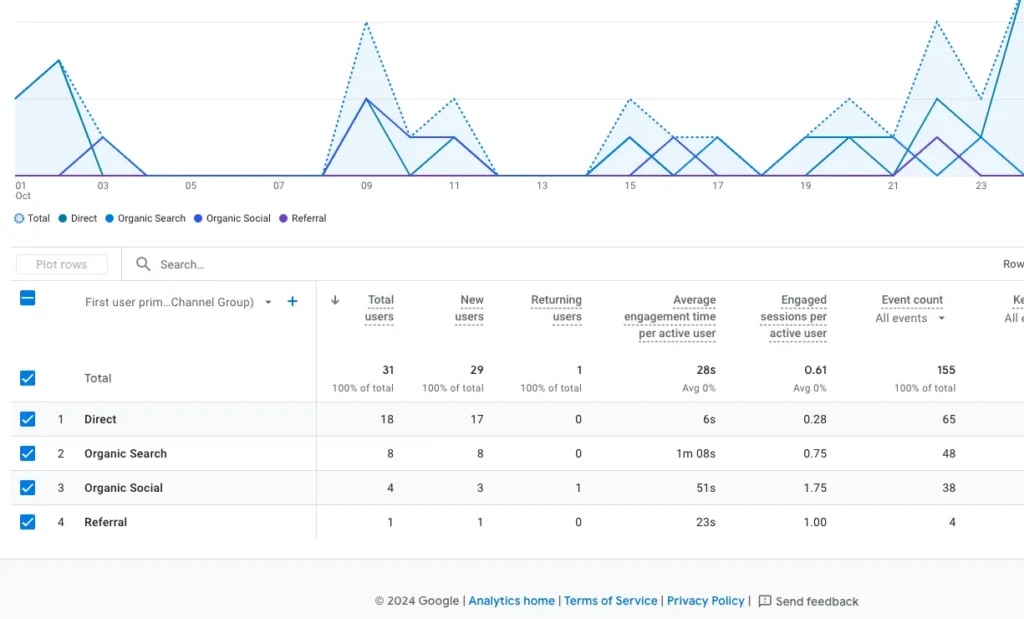
Ranking for high-competition keywords often requires more than just optimizing on-page content. You need to amplify your content through various channels.
Social Media Engagement: Share your content on LinkedIn, Twitter, and relevant forums. The initial engagement can help drive traffic, which signals relevance to Google.
Content Repurposing and Syndication: Repurpose your content into different formats—videos, infographics, and podcasts—and distribute them across various platforms like YouTube, Pinterest, and Medium. This multichannel approach helps extend your reach and build backlinks.
6. User Experience and Engagement Signals
Google pays close attention to how users interact with your content. Positive engagement signals such as high dwell time, low bounce rates, and return visits are all indicators of valuable content.
Internal Linking: Use internal links to guide readers to other relevant content on your site, which helps reduce bounce rates and increases time spent on the site.
Clear Navigation and Fast Load Times: A well-structured website with fast load times ensures users have a positive experience, which in turn signals to Google that your site is worth ranking.
7. Regular Content Updates
Google loves fresh content. Regularly updating your existing articles with new information, updated data, and additional insights keeps them relevant and signals to Google that the content is current.
Content Refresh Strategy: Identify your top-performing content and refresh it periodically. Adding updated statistics, recent examples, or expanding sections can give new life to older articles and improve their rankings.
How to Rank Effectively
Ranking effectively on search engines involves a combination of strategies designed to create, optimize, and amplify your content. Here’s how you can rank effectively in today’s competitive digital landscape:
1. Provide Genuine Value
Google rewards content that offers valuable, actionable information that stands out from the rest. The focus should always be on solving real problems your audience faces.
Deep Dive into Topics: Go beyond surface-level content. Provide data-backed insights, detailed guides, case studies, and expert opinions that add depth to your content. The more informative and useful your content is, the higher the chances of it being recognized by search engines.
Unique Content: Avoid duplicating information available elsewhere. Original research, proprietary data, or unique viewpoints will help your content stand out.
2. Founder or Leader Involvement

Authentic insights from company founders or leaders help build trust and resonate more with your audience. When founders are involved, the content often feels more genuine and authoritative.
Thought Leadership: Share thought leadership pieces, industry insights, and personal anecdotes. These not only create a stronger connection with your audience but also establish your brand as a leader in the industry.
Personal Branding: Establish a personal brand alongside your company’s brand. This can be through personal blog posts, LinkedIn articles, or video content where you share your journey, expertise, and vision.
3. Leverage Multichannel Marketing
Amplify your content across multiple platforms to reach a wider audience and boost engagement.
Content Syndication: Share your articles on platforms like Medium and LinkedIn Pulse. This increases visibility, drives more traffic, and can lead to higher engagement.
Social Media Campaigns: Use social media platforms to distribute content and engage with your audience. Post snippets of articles, infographics, or key takeaways to generate interest and direct readers to the full content.
Influencer Collaborations: Collaborate with influencers in your niche to share your content. Influencer endorsements can lead to greater credibility and reach for your content.
4. Optimize for User Experience
A good user experience is crucial for both SEO and audience retention. Content that is difficult to read or navigate will quickly lose readers.
Structured Content: Use clear headings, bullet points, and short paragraphs to make your content easily scannable. Readers should be able to find key information quickly.
Mobile Optimization: Ensure your content is accessible and looks good on all devices. Mobile traffic accounts for a significant portion of web traffic, and a poor mobile experience can hurt your rankings.
Interactive Elements: Incorporate interactive elements like quizzes, surveys, or calculators to keep users engaged and on the page longer.
5. Use Data to Drive Decisions
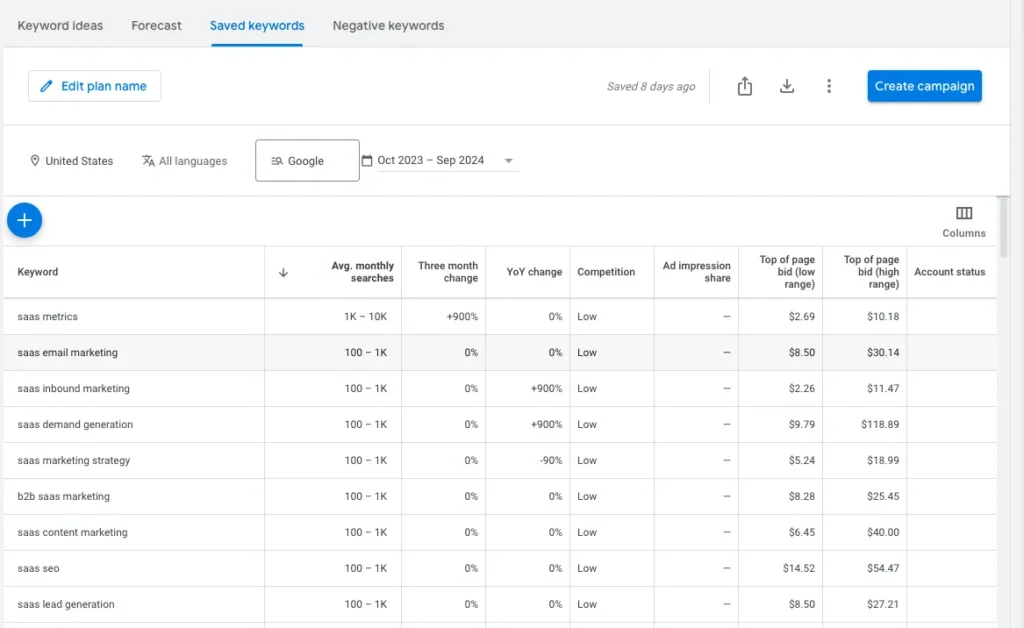
Data should guide your content strategy, from topic selection to optimization.
Keyword Performance Analysis: Regularly analyze which keywords your content is ranking for and adjust your strategy accordingly. Identify gaps and opportunities based on performance data.
Engagement Metrics: Track metrics like average time on page, bounce rate, and conversion rate. High engagement metrics indicate valuable content, and understanding what works can help you replicate success across other content pieces.
A/B Testing CTAs: Experiment with different calls to action to determine which versions perform better. Testing can lead to significant improvements in conversion rates.
6. Create Evergreen Content
Evergreen content remains relevant over time and continues to drive traffic long after it’s published.
Topic Selection: Choose topics that are not time-sensitive and provide ongoing value. Examples include how-to guides, ultimate resources, and fundamental industry concepts.
Periodic Updates: While evergreen, it’s still important to update content periodically to keep it accurate and relevant. This also signals freshness to Google, improving rankings.
7. Authority and Trust Signals
Establish your site as an authority in your niche to boost ranking potential.
Testimonials and Case Studies: Showcase testimonials and case studies from clients to build credibility. Social proof helps in establishing trust and demonstrating the impact of your content or services.
Awards and Certifications: Display any industry awards, certifications, or partnerships that add to your authority. Trust signals can help differentiate your brand in a crowded market.
8. Consistent Branding Across All Channels
Consistency in branding helps create a cohesive identity, which strengthens trust and recall.
Visual Identity: Use consistent brand colors, fonts, and design elements across all content formats. A unified visual identity makes your brand instantly recognizable.
Tone of Voice: Ensure that the tone of voice is consistent across articles, videos, social media posts, and other formats. Whether formal, conversational, or humorous, a consistent tone helps build a relationship with your audience.
In essence, ranking effectively on SERPs today involves more than just good content—it’s about value, authenticity, consistency, and strategic amplification. By focusing on these elements, you can ensure your content reaches its intended audience, provides real value, and ranks well on search engines.
How to Approach Marketing in 2025
As we move into 2025, the approach to marketing is evolving beyond the traditional tactics of backlinks and on-page SEO. The landscape is shifting towards a more holistic view, where user experience, engagement, and brand reputation are increasingly becoming the critical factors for success. Here’s how to adapt your marketing strategy to meet these changes:
1. User Experience and Engagement Are Crucial
Ranking is no longer just about optimizing for search engines; it’s about providing a seamless experience for users. Factors like page speed, mobile usability, and overall website navigation play a major role in how users engage with your content, and Google takes note of these engagement signals.
Interactive Content: Adding elements like quizzes, surveys, or interactive infographics can significantly enhance engagement. These features keep users on your site longer, boost interaction, and reduce bounce rates, all of which positively impact your rankings.
Personalization: Tailor content to individual users where possible. Personalized experiences, such as recommended articles based on browsing behavior, make users feel understood and catered to, increasing the likelihood of conversions.
2. Assess Whether SEO Is Right for Your Industry
SEO may not be equally effective for all industries, especially those with high competition and low keyword opportunities. In some cases, other forms of marketing, such as influencer partnerships or paid ads, can yield better ROI.
Industry Analysis: Conduct a thorough analysis of your industry to determine whether SEO is a viable investment. For sectors with intense competition, it may be more strategic to build a strong social media presence or invest in thought leadership.
Diversify Your Marketing Efforts: Don’t put all your eggs in one basket. Diversifying your marketing strategy can help mitigate the risks associated with heavy competition in SEO. Utilize paid ads, influencer marketing, and community building to complement your organic efforts.
3. Focus on Community Building and Brand-Driven Content
For industries where SEO is highly competitive, building a community around your brand can be a more sustainable way to grow. Brand loyalty and word-of-mouth are powerful assets that cannot be easily replicated by competitors.
Social Communities: Create and nurture online communities on platforms like Facebook, LinkedIn, or even Discord. These platforms offer a space for your audience to engage directly with your brand and with each other, fostering loyalty and trust.
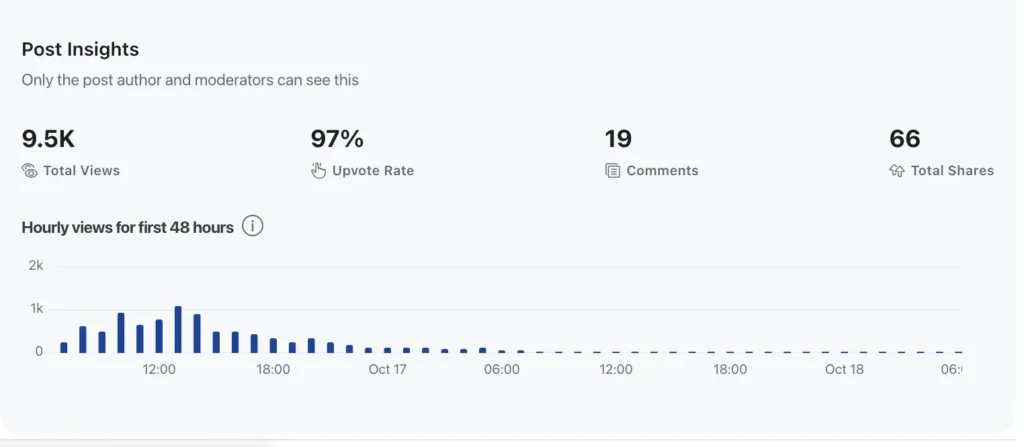
User-Generated Content: Encourage your community members to share their experiences with your products or services. User-generated content not only builds trust but also provides you with authentic material to use in your marketing efforts.
4. Prioritize Brand Development and Visuals
In 2025, visuals and storytelling will continue to play an instrumental role in establishing your brand’s presence. A strong brand identity builds trust, which is critical for engagement and conversion.
Visual Identity: Create visually appealing content, including graphics, charts, and videos, to complement your written content. Visuals enhance user experience, improve shareability, and make your brand memorable.
Storytelling: Connect with your audience on an emotional level through storytelling. Share your journey, the challenges you’ve overcome, and the vision behind your brand. Storytelling humanizes your brand and makes it more relatable, which is essential for building long-term relationships.
5. Leverage AI and Automation
The use of AI tools in marketing will become even more prevalent in 2025. From content research and SEO analysis to customer interactions, AI and automation can significantly streamline your marketing processes.
Content Creation and Curation: Leverage AI for generating content ideas, optimizing existing content, and even drafting outlines or initial versions. AI can also assist in identifying trending topics, ensuring your content stays relevant and timely.
Automated Customer Interactions: Chatbots and automated responses can enhance user experience by providing instant support. This is particularly useful for handling common queries, freeing up human resources for more complex customer interactions.
Data Analysis and Insights: AI can help you analyze data more effectively, providing insights into user behavior, campaign performance, and emerging trends. Use these insights to make informed decisions and fine-tune your marketing strategies.
6. Evaluate the ROI of SEO
As SEO becomes increasingly competitive, it’s essential to evaluate whether the return on investment justifies the resources required.
Keyword Opportunity Cost: Consider the opportunity cost of focusing on competitive keywords. If ranking for a high-volume keyword will require significant time and investment, it might be more efficient to target a series of long-tail keywords that can yield quicker wins.
Measuring SEO Success Beyond Rankings: Track metrics beyond just rankings—focus on traffic quality, engagement metrics, and conversions. SEO should not be seen as an isolated channel but rather as a part of a broader marketing funnel.
7. Embrace a Multi-Channel Approach
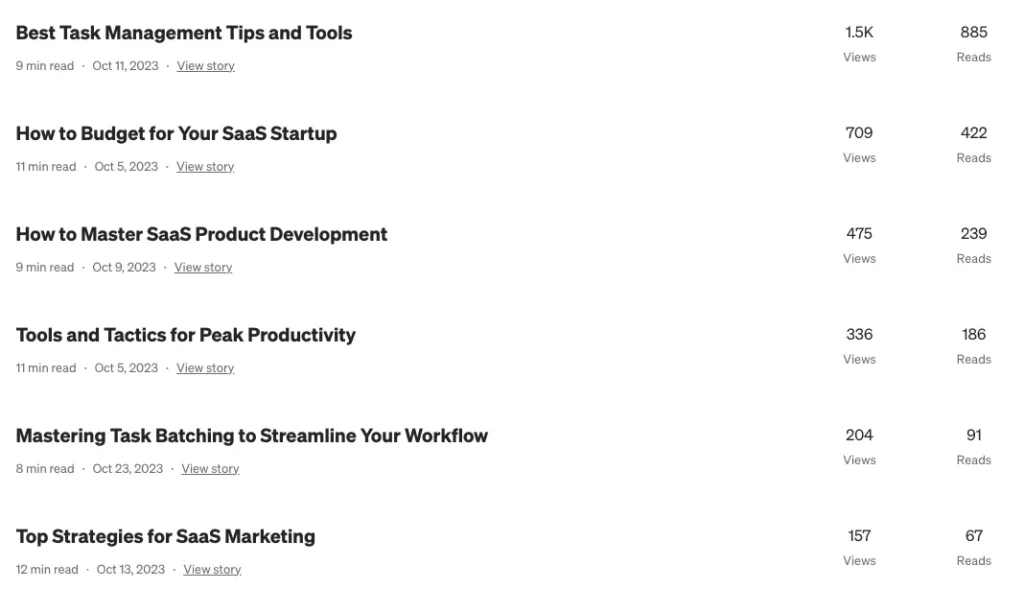
Relying solely on SEO can be risky, especially with frequent algorithm changes. A multi-channel strategy ensures that your brand continues to reach its audience even if one channel underperforms.
Content Syndication: Publish your content across multiple platforms to extend your reach. Channels like Medium, LinkedIn, and industry-specific forums can drive traffic and enhance your brand authority.
Video Marketing: Video content is one of the most engaging formats. Platforms like YouTube, Instagram Reels, and TikTok can help you reach new audiences and add a human touch to your brand.
Email Marketing: Maintain an email list to nurture relationships with your audience. Email marketing provides a direct channel to communicate with your customers, share content, and promote offers.
8. Prioritize Ethical and Transparent Marketing
Consumers in 2025 are likely to favor brands that are transparent, authentic, and ethical. Be clear about your values and business practices to build trust.
Transparency in Advertising: If you’re using paid ads or sponsored content, be transparent about it. Users appreciate honesty, and being upfront can enhance your credibility.
Corporate Social Responsibility (CSR): Highlight any CSR initiatives your company is involved in. Whether it’s sustainability efforts or community outreach, showcasing your commitment to making a positive impact can resonate strongly with your audience.
In summary, marketing in 2025 is about more than just acquiring backlinks and optimizing on-page SEO. It’s about understanding your audience, providing a top-tier user experience, and building a trustworthy and relatable brand.
Focusing on community, diversifying your channels, and prioritizing authenticity, can help you create a marketing strategy that not only reaches but resonates with your target audience.
To Sum it Up
These are just some of the lessons I learned from being involved in two high-impact B2B content projects. By focusing on creating quality content, amplifying it across different channels, and understanding the numbers behind conversions, I was able to make a significant impact.
Moving forward, the key is to remain adaptable. The digital landscape changes quickly, and staying ahead requires continuous learning, experimentation, and a willingness to pivot when necessary.
